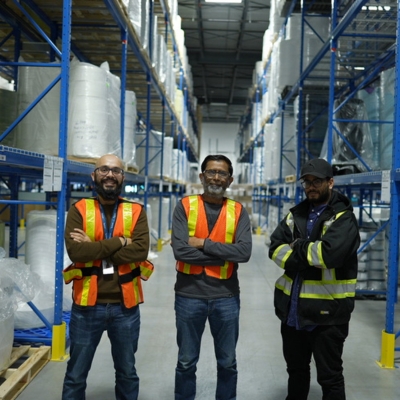Medical vs Non-Medical Masks

Updated on September 26, 2025: This article was originally published in July 2021 and has been updated to reflect recent changes in ASTM standards and testing pertaining to PFE and Delta P ratings.
Considerations to Optimize Protection
Events in 2020 have thrust the protective benefits of medical masks and other PPE into the public spotlight.
These events have required healthcare facilities to consider the best ways to protect their workers and patients with massive spikes in demand and a range of new variables to consider.
Common protocols in hospitals, ambulatory care centers, and community clinics today likely looked very different just a few months ago.
With masks a central component of both public and healthcare facility infection control protocols, understanding which masks offer the best protection for specific cases is essential to optimizing protection levels.
Medical and Non-Medical Masks Defined
At the most basic level, distinguishing between medical and non-medical masks is as simple as looking at their intended usage.
Non-medical masks are for the general public or use in non-healthcare related environments. They should be worn when there is low risk of exposure, outside of healthcare facilities, and/or when social distancing may be difficult.
In contrast, medical masks are designed as PPE for use in medical environments.

Looking deeper into the differences, you’ll also find that medical masks feature many different designs and materials to provide different levels of protection at varying price points.
Many designs fall into one of two categories:
- Surgical and procedural masks
- Respirators
While N95 respirators have seen a surge in publicity in 2020, disposable surgical and procedural masks are by far the most commonly used mask types in modern healthcare.
Medical Mask Ratings Explained
With so many mask designs available, how can you determine the best single-use medical masks for your intended use?
ASTM (American Society for Testing and Materials) ratings provide data making it easier to compare mask protection and performance across a number of critical protection types.
The ASTM is an international standards organization that develops and publishes voluntary consensus technical standards for a wide range of materials, products, systems, and services—including those in healthcare.
Their PPE ratings offer a look at critical considerations to make comparing the protective characteristics of different models simpler.
ASTM F2100, the current standard, reviews 5 basic criteria:
- BFE (Bacterial Filtration Efficiency): The ability to filter bacteria
- PFE (Particulate Filtration Efficiency): The ability to filter sub-micron particles
- Fluid Resistance: The ability to prevent fluid penetration through the mask to the wearer
- Delta P (Pressure Differential): Measures how light and breathable a mask feels
- Flame Spread: The ability to withstand exposure from flame.
ISO (International Organization for Standardization) 10993-5 and ISO 10993-10 also provide certifications for skin sensitivity and cytotoxic testing, ensuring optimal comfort and minimizing the risk of adverse reaction from mask materials and mask usage.
ASTM ratings span from Level 1 to Level 3. Each offers an increased level of protection across the range of criteria.
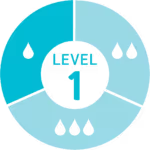
ASTM Level 1 (Low) Rated Medical Masks
Light / minimum BFE & PFE protection used for general procedures, minimally invasive surgery, ophthalmology, and respiratory etiquette.
- BFE at 3.0 micron ASTM F2101 ≥ 95%
- PFE at 0.3 micron ASTM F3502 ≥ 80% (Sept. 2025 update)
- Delta P < 24.5 mm H2O (Sept. 2025 update)
- Fluid Resistance to Synthetic Blood at 80 mm Hg
- Flame Spread Class 1 per 16 CFR part 161

ASTM Level 2 (Medium) Rated Medical Masks
High BFE & PFE protection with moderate fluid resistance for procedures such as general surgery and endoscopy while providing greater breathability than high barrier (Level 3) masks. Designed to resist a splash or spray at arterial pressure.
- BFE at 3.0 micron ASTM F2101 ≥ 98%
- PFE at 0.3 micron ASTM F3502 ≥ 85% (Sept. 2025 updates)
- Delta P < 29.4 mm H2O (Sept. 2025 updates)
- Fluid Resistance to Synthetic Blood at 120 mm Hg
- Flame Spread Class 1 per 16 CFR part 1610
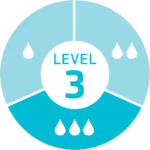
ASTM Level 3 (High) Rated Medical Masks
High BFE & PFE protection with the highest fluid resistance. Designed to resist a splash or spray during tasks like orthopedic surgery or trauma.
- BFE at 3.0 micron ASTM F2101 ≥ 98%
- PFE at 0.3 micron ASTM F3502 ≥ 85% (Sept. 2025 updates)
- Delta P < 29.4 mm H2O (Sept. 2025 updates)
- Fluid Resistance to Synthetic Blood at 160 mm Hg
- Flame Spread Class 1 per 16 CFR part 1610
What Can Impact Mask Ratings?
With an understanding of mask rating standards, we can now discuss how a mask can meet these requirements.
Most factors fall into one of two categories:
- Design
- Materials
Design considerations include:
- Overall fit and sizing: Adult, pediatric, etc.
- Total face coverage: Mouth only, optional face shields, duckbill designs, etc.
- How the masks are secured: Surgical ties, procedure earloops, procedure headstraps
- The number of pleats and/or plies in the mask design: While material choice will also make a difference, across a single material type multiple plies/pleats will typically offer enhanced protection — sometimes at the cost of heat buildup and breathability.
Materials choice will also impact mask protection levels and comfort. Common materials include:
- Polypropylene (most common)
- Polystyrene
- Polycarbonate
- Polyethylene
- Polyester
- Cloth
The ability to protect patients and healthcare workers from infectious disease or to prevent contamination of sensitive environments isn’t about a single metric in the ASTM rating, but a combination of all the considerations.
Since infection vectors may vary, each aspect plays a crucial role in how medical masks prevent the spread of disease.
However, when used properly, a PRIMED mask rated level 1 by ASTM standards will outperform any unrated non-medical face mask.
A Level 3 rated mask is recommended in any situation where infection containment is a priority and wearers require protection from a wider spectrum of potential threats.
Confirming Mask Ratings (and Ensuring Safety)
As mentioned above, a rating is a sum of multiple features and considerations. Each element alone might offer completely different (and often worse) protection than the elements offer when combined.
This became particularly important in 2020 as the global pandemic tested mask supply chain. Many non-medical mask manufacturers and suppliers started quoting ASTM standards and ratings for individual factors (such as BFE, PFE, or Delta P) without officially rating every feature of the mask.
However, even when data and ratings appear complete, it is critical to check the methods used to verify ratings.
For example, some manufacturers use the Modified Greene & Vesley method to determine BFE rating. ASTM does not recommend this method for product comparison as it will result in artificially inflated filtration results when compared to the recognized ASTM test method.
Tests for PFE rating might use different particle sizes to make results look better. ASTM F2100 specifies that a particle size of 0.3 microns must be used.
Other manufacturers or mask providers might instead avoid the topic of ratings altogether, focusing instead on filtration rates, the number of layers, or the quality of materials used.
If a manufacturer or supplier cannot provide you with ASTM testing information related to their masks, it could indicate their masks are of inferior quality and could put both your staff — and the patients they are caring for — at greater risk of infection.
All PRIMED Level 1, Level 2, and Level 3 ASTM-rated medical masks meet strict ASTM testing requirements. We also list test-related information directly on the packaging to avoid any confusion about mask performance and which mask is best suited for a given care environment.
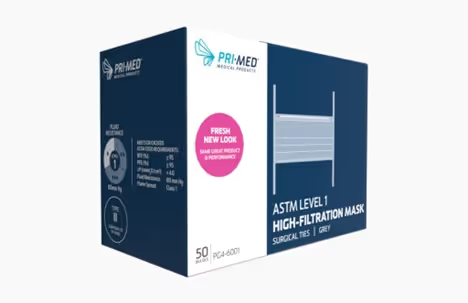
Common Questions about Medical Masks
1. How long are medical face masks effective?
Higher ratings will mean greater filtration longevity. This means if you’re looking for the longest duration between replacements with all other factors not considered, a Level 3 rated mask is the way to go.
However, wet, torn or dislodged masks should be considered compromised regardless of rating. A mask’s effective duration will also depend on humidity levels, respiration rate, nasal discharge, talking, and other environmental/behavioural factors.
2. What is the difference between a surgical mask and a procedure mask?
A surgical mask is used inside the operating room or within other sterile procedure areas to protect the sterile field from possible contamination, primarily as a result of coughing, sneezing or talking.

Surgical masks have ties so that they can be adjusted for fit, and are tied over the top of a surgical cap or a bouffant cap.
A procedure mask is used to protect clinicians while performing patient procedures, or when caring for patients in isolation. Generally used for respiratory etiquette, these masks prevent clinicians, patients and visitors from spreading germs by talking, coughing, or sneezing and the transfer of respiratory secretions, fluids or other droplets.
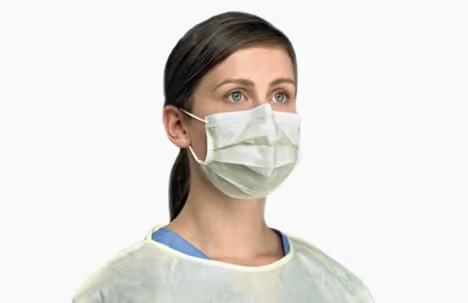
Procedure masks have earloops for quick donning and can be worn without a surgical cap.
3. Is a mask’s fit important?
Mask fit is critical as the mask’s ability to protect is only as effective as its fit.
While a surgical or procedure mask is not intended to provide the same seal as a respirator mask, there should be minimal gaps along the side, around the nose, or under the chin to prevent air and droplets from bypassing the filter medium.
You should also always properly adjust the mask to fully cover both the mouth and nose. Masks should not be worn underneath the nose or dangling around the neck – they should either be fully on or disposed of.
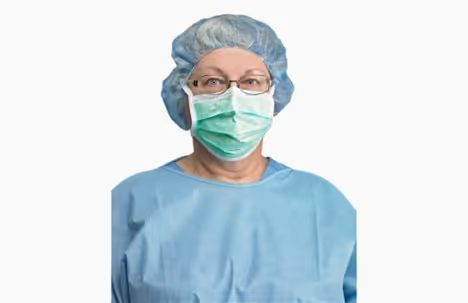
A well-fitting mask stays in place over the nose and cheeks and even a regular mask will prevent fogging of eyeglasses if it fits properly. However, if you have issues with fogging lenses, PRIMED offers anti-fog mask features designed to combat this and ensure optimal visibility and protection.

4. How can I be sure I’m wearing my mask correctly?
While mask designs may vary, most medical masks include a few common features to help with fit.
Always ensure:
- The aluminum nose piece is at the top.
- The white (or smoothest side) is on the inside against the wearer’s skin—the colour always faces out.
- The pleats fall downwards and away from the nose (called a “waterfall” pleat).
5. How do surgical/procedure masks compare to respirators?
Medical masks (surgical/procedure masks) are looser-fitting masks that cover the mouth and nose. They are designed to stop large droplets and splashes or sprays but are not designed to seal tightly to the face or filter the smallest airborne contaminants.
A respirator is an item of PPE designed to reduce exposure to airborne contaminants. Known airborne pathogens include TB, SARS, Anthrax, and Hantavirus. Respirators must be individually selected to fit the wearer’s face and shown to provide a good seal. They typically must also be certified by a regulatory party and used within a comprehensive respiratory program including fit testing and training.
Respirator names typically include a letter followed by a number; the most common example being the N95 mask.
The letter designates resistance to oil-based particles with N meaning non-resistant, P meaning partially resistant, and R meaning resistant. In most cases, P and R respirators are reserved for industrial work and other environmental concerns.
The number which follows indicates the level of airborne filtration offered with breathability decreasing as the number rises.
For additional information about PRIMED Masks, ASTM standards related to medical masks, and best practices for medical mask usage, be sure to consult our ASTM Booklet.
Key Takeaways
- Non-medical face masks are intended for the general public and use in non-healthcare environments.
- Medical face masks are designed for use as PPE in healthcare settings and use cases.
- Medical face mask options include surgical masks, N95 masks, and respirators.
- ASTM mask ratings provide a wealth of information related to protection levels. Even a Level 1 rated medical mask offers far greater protection than unrated non-medical masks. But if there is any possibility of infection spread, a Level 3 rated mask is recommended.
- Design and materials can have a substantial impact on medical mask ratings.
- Medical masks should be changed between patients or when wet, soiled, or dislodged to ensure optimal protection.
- Fit is critical for optimizing protection. Always follow all mask donning, doffing, and fitment recommendations.
PRIMED offers a selection of medical face mask designs ranging from ASTM Level 1 to ASTM Level 3. Whether you’re protecting the sterile environment of the operating room or looking for affordable options for use in the waiting room, we have a model to address your needs. Contact us to see how our PRIMED medical masks can help protect your workers and patients today.
Related Resources
PRIMED MRI Safe Mask: Safe by Design for Purpose-Built Protection
PRIMED's ASTM Level 3 MRI Safe Masks offer a high-quality, purpose-built solution that merges MRI compatibility with premium protection.
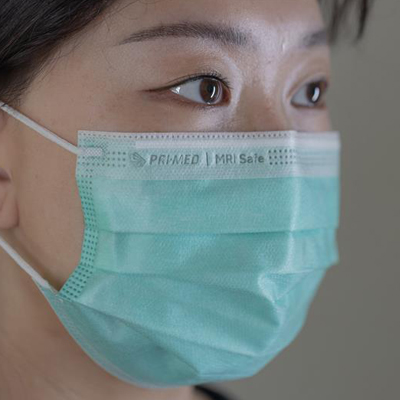
From the Sterile Core to the Decision Table: Elevating the Voice of MDR Professionals
MDR professionals don’t just process products, they influence how they are designed, selected, and standardized.
%20-%20Sterlization%20Wrap%20Display%20(1).jpg)
Protecting with Purpose: The Supply Chain Behind the Mission
PRIMED, resilient through the pandemic, has evolved our supply chain - now stronger, smarter, and ready to meet future challenges with agility and confidence.
